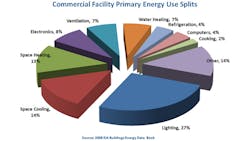Buildings in Europe devour a prodigious 40% of total available end-user energy (see figure above). Obviously, curtailing that inefficiency becomes imperative, particularly in light of the European Union’s (EU) goals to reduce CO2 emissions by 20%, improve energy efficiency by 20% and achieve 20% renewable power generation by 2020.
One of the EU’s prime strategies toward achieving these environmental ambitions involves the use of information and communications technology (ICT). It believes ICT will be able to facilitate a “whole building approach” in design and building operation through simulation, modeling, analysis, monitoring, and visualization tools. ICT also can play essential roles in simplifying the implementation of energy policies, and in measuring their effectiveness.
To support this course of action, the EU Directive on the Energy Performance of Buildings was instituted to provide a methodology that calculates the energy performance of buildings. If successfully implemented, the data provided would assist in identifying common inefficiencies, best practices, and opportunities to improve energy usage.
Such a meritorious stance from the European Commission must be applauded. However, these proposals will only develop into pragmatic reality by enlisting expertise from the electronics industry.
With this in mind, 26 industry companies from five European countries will partner over a three-year period in what is hoped will be trailblazing research on environmental sensors and sensor networks. The mission is to develop energy-efficient solutions aimed at cutting power usage in buildings.
The “Environmental Sensors for Energy Efficiency” (ESEE) project is led by German chipmaker Infineon Technologies and supported by the EU through its European Nanoelectronics Initiative Advisory Council (ENIAC) Joint Undertaking, as well as by national and regional funding of the participating nations. Among others, Germany’s Federal Ministry of Education and Research supports the ESEE project under its “Information and Communication Technology 2020” program.
Essential Component
ESEE plans to target applications that require extremely reliable information about environmental conditions to identify measures that will help reduce energy consumption. When combined with solutions for air-quality management, the project believes the potential to inner-building energy savings could go beyond 30%.
All of this sits very comfortably with the European Commission’s Europe 2020 initiative to cut greenhouse gas emissions and improve energy efficiency. One key enabler, though, surrounds the development, design, and manufacture of sensor- and energy-management systems in Europe at competitive costs.
The ESEE project is timed to conclude in March 2016. It will be interesting to see what technological progress is made, considering sensors and controls continue to be profoundly overlooked despite the critical roles they play in building energy management.
In addition to the environmental imperative to minimize energy use, there’s considerable financial incentive to develop building control networks that fully exploit interconnected sensor-based systems. Industry analysts suggest the sensors market in the U.S. and Europe is set to grow nearly 20% annually from now until 2020. In value terms, the U.S. market would be worth $2.14 billion by that time, while the Europe sector would reach $1.93 billion.
Lux Research’s recent report “Sensors and Controls for Building Energy Management Systems (BEMS): Providing the Neural Network to Net-Zero Energy” sheds another light. It indicates that key to sensor sector growth will be a profusion of advanced non-invasive, cost-effective, and quick-to-install sensor and control technologies that can overcome existing cost constraints.
It is certainly true that wireless-based, energy-harvesting, network-enabled sensors, switches, and associated media technologies will lower installation costs.
In summary, it appears that the overall environmental prospects look positive in terms of more efficient building consumption. More so when taking into account those companies involved in the research and development of capable sensor control networks are fueled by the dual incentives of reducing global emissions and substantial commercial reward.

